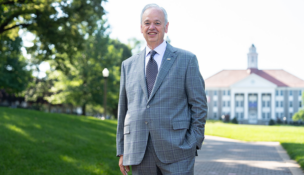This fast-growing medical specialty surged over past decade

An attending hospitalist with VCU Health, Dr. Ajin John Persaud sees emergency room patients who are being considered for hospital admission. “I felt like it was a job that would allow me to make a bigger impact than ... doing a specialty,” she says. Photo by Caroline Martin

An attending hospitalist with VCU Health, Dr. Ajin John Persaud sees emergency room patients who are being considered for hospital admission. “I felt like it was a job that would allow me to make a bigger impact than ... doing a specialty,” she says. Photo by Caroline Martin
This fast-growing medical specialty surged over past decade
A growing number of in-demand physicians are seeing patients without appointments, checking up on them multiple times a day and providing comprehensive care. But there’s a catch: You shouldn’t aspire to see these doctors because they exclusively care for hospitalized patients.
Less than 30 years since the designation was coined, hospitalists have transformed medicine. Between 2012 and 2022, the number of hospitalists surged nearly 80% to more than 50,000, according to figures provided by the Society of Hospital Medicine, an industry association representing hospitalists and other physicians practicing hospital medicine.
“It’s an enormous number,” says the society’s CEO, Dr. Eric Howell. “As a specialty, we’re definitely young and fast-growing.”
Howell’s use of “specialty” may rankle those who don’t consider hospital medicine a specialty since there’s no specific board certification that’s currently required of these doctors unlike, say, cardiologists. But as is true of any specialist, hospitalists must possess a specific and unique skill set.
“Hospitalists are experts in taking care of patients and managing the complexities of the hospital, which over the last 20 years has gotten really complicated,” says Dr. Alan Dow, division chief of hospital medicine at VCU Health and a professor in the VCU School of Medicine’s Department of Internal Medicine. “The reality is that most people who are hospitalists view themselves as a distinct practice or specialty.”
Specialty or not, hospitalists play a vital role in providing continuity in medical care for patients while hospitalized and often spearhead quality improvement initiatives to enhance patient care and create more efficient processes in hospitals. And thanks to robust demand among employers in Virginia and beyond, doctors have flocked to hospital medicine.
Tracking with national trends, one of Virginia’s largest health systems is adding more hospitalists to payrolls. Sentara Health’s hospitalist group grew 25% over the past four years, to a total of 217 full- and part-time hospitalists, and it’s now the Hampton Roads health care system’s second largest specialty, behind primary care physicians, according to Dr. Albert Soriano, director of medical operations for Sentara, which operates 11 hospitals in Virginia and one in North Carolina.
Hospitalists play an “integral” role in delivering health care at Sentara hospitals, and each patient interaction is an opportunity to offer a steadying voice of information and reassurance, Soriano says. “Hospitalists are there every day trying to improve patient care at an individual level, while impacting care from a hospital and system perspective.”
Demand for hospitalists isn’t likely to ease anytime soon, though the role may evolve in coming years.
Changing care
If a hospital provides inpatient care, the odds are very good it employs hospitalists, who have become pervasive in health care in recent decades. In pre-hospitalist days, when patients were admitted to the hospital, their primary care physician was responsible for coordinating care — a dynamic that became untenable as demands on doctors grew and the bar for hospitalizing patients grew higher.
Beginning in the mid-1990s, a solution emerged — hospitalists. These doctors coordinate care for hospitalized patients and play an integral role in patient care, unburdening primary care physicians.
“Medical illnesses are more complicated than 20 to 30 years ago,” notes Dr. Amber Inofuentes, an associate professor of medicine and section head of hospital medicine at the University of Virginia School of Medicine. “The acuity and complexity of patients when they’re hospitalized has changed so significantly that the knowledge and skill set that’s needed for the role of a hospitalist is very different.”
Today’s hospitalists must be good communicators and effective problem solvers who are relentless about improving care and making it more efficient.
“Hospitalists, more than really any other profession, span the bridge between the science of medicine and then actually delivering the care to patients,” notes Dr. Stephen Biederman, an attending hospitalist and associate chair for quality and safety in the Division of Hospital Medicine at VCU Health. He’s also an assistant professor at the VCU School of Medicine.
These doctors serve as a central point of contact during a patient’s hospitalization, while coordinating with nurses, social workers, case managers and other hospital staff. The team-based approach and way that hospitalists interact with patients is unique, says Dr. Jordan Scharping, a professor of internal medicine at Virginia Tech Carilion School of Medicine and a hospitalist at Carilion Clinic.
“You get a lot of concentrated time with patients, you see them day after day, talk to them, get to know them better and see the effect of the treatments you enact,” Scharping says. “It’s unlike anything else, in my opinion.”
As hospitalists have evolved from a purely clinical role to serving broad, operational needs in hospital systems, they’ve become indispensable, according to Dr. George Hoke, a hospitalist and associate professor of internal medicine at U.Va.’s medical school. “A hospital couldn’t run without hospitalists,” Hoke says. “If we all didn’t show up to work tomorrow, it would be a big problem.”
A multifaceted career
One thing that’s not a big problem? Recruiting future hospitalists. A career in hospital medicine may attract doctors for two very practical reasons: The schedule and pay.
A shift schedule is common, as many hospitalists work seven days on, followed by seven days off, and this provides a more attractive work-life balance in the eyes of many young doctors. Meanwhile, hospitalists typically outearn their counterparts who work as internal medicine general practitioners, and they don’t have to deal with the same amount of after-hours paperwork.
Such attributes have made a career in hospital medicine more attractive. That’s especially true for doctors who enjoy the fast-paced life and challenges of treating patients suffering from a wide range of ailments, along with the opportunity to play a role in making efficiency improvements.
A “vast majority” of hospitalists come out of internal medicine residency programs, where they spend most of their training in acute care hospitals, notes Dr. Jon Sweet, a professor of internal medicine and chair of the department of medicine at the Virginia Tech Carilion School of Medicine. “They get really good at caring for the critically ill.”
This was the case for Dr. Jody King, who found during her residency that she preferred to care for patients who were hospitalized with a whole range of diseases, illnesses or other ailments. On a typical day doing rounds, she says, she found she could sometimes achieve nearly instant results treating patients.
“You’re getting people when they’re the most scared, the most vulnerable and the most ill,” says King, an associate professor of internal medicine and associate program director of the internal medicine residency program at Macon & Joan Brock Virginia Health Sciences at Old Dominion University. “I saw the opportunity to make a big impact in a small amount of time.”
Hospitalists also are well-suited to become involved in quality improvement initiatives or assume roles in administrative and operational leadership. “Hospitalists are really perfectly poised to do that,” says Biederman, “because we are so attuned to the complexity of the medical system.”
Hospitalists are uniquely qualified to identify ways to improve and streamline patient care and processes, notes Dow. “We definitely have people that are pretty junior that step into big leadership roles because they show a knack for being able to think about the patient at the same time as they think about the system.”
Job seekers’ market
Demand for hospitalists is so robust that doctors can readily find employment across the U.S. upon completing their residency programs. “There’s no place that doesn’t need you,” says Hoke. “It’s easy to find work.”
What’s more, new hires can afford to be choosy by prioritizing what they want a hospitalist job to look like in terms of shift hours, the quantity of patients they’re expected to see and how bonuses are calculated, adds ODU‘s King. “They can find a job quickly as a hospitalist.”
That tracks with what Dr. Ben Robinson has been seeing in the job market. Robinson, a member of the 2025 internal residency program at the U.Va. School of Medicine, says there’s a “pretty good market for job openings” for physicians in general, though he’s attracted mostly to the work hospitalists do. “That very broad sense and holistic view of the patient’s well-being was what drew me to general medicine, and working in a hospital is a very satisfying environment.”
Robinson decided on his chosen career path before he entered his third year of residency. That’s typically when doctors in internal medicine residency programs must decide if they want to work in an inpatient setting as a hospitalist vs. working in an outpatient clinic as a general practitioner.
There have since been other shifts in internal medicine. Some hospitalists now are expanding their care for patients after they’ve been discharged from the hospital. “That’s an additional step many places are introducing.”
Dr. Ajin John Persaud is among the hospitalists taking on some of these post-discharge duties. As an attending hospitalist in VCU Health’s Division of Hospital Medicine, John Persaud sees patients in the emergency room being considered for hospitalization to determine if they need to be admitted, brought to the observation unit or discharged. In addition to being the first point of contact for patients, she’s also often their last point of contact.
“When a patient leaves the hospital, that’s not the end of their treatment plan,” John Persaud says. This more holistic approach to care made hospital medicine attractive to her, particularly because she could help patients who don’t have a primary care physician. “I felt like it was a job that would allow me to make a bigger impact than perhaps doing a specialty.”
In fact, a very important role for hospitalists is to bridge the gap between a very complicated hospital stay and finding more continuity in care from a long-term physician, notes UVA Health’s Inofuentes.
In 2023, VCU Medical Center launched a Hospital at Home program for some patients who have sufficient care needs to be in the hospital but instead can be treated in the comfort of their homes. “The patients love it,” Dow says.
While hospitalists say they love their jobs, they also acknowledge a number of challenges that still need tackling. By far, the trickiest problem is that the explosive growth in hospital medicine has seemingly come at a price: Many would-be primary care physicians have opted instead for career as hospitalists, and that dynamic only further exacerbates the primary care labor shortage — which potentially means more patients could wind up in the hospital.
But the future may also bring exciting opportunities in the field. If the number of hospital medicine fellowships expands, that may pave the way for hospitalists to do quality improvement research and become more involved in ways to improve hospital practices and outcomes, according to Virginia Tech’s Scharping. Likewise, ODU is encouraging faculty to get involved in clinical research to study patient outcomes that may reshape how care is offered.
Involving patients in their care is also important, hospitalists say. Over the years, patients commented that they didn’t know who to talk to while hospitalized or who their doctor was, John Persaud says. So VCU Health recently launched a pilot program in which hospitalists give out business cards with their photos and a little bit of personal information so patients can feel more connected to them.
Such efforts are also a way to combat a misperception that physicians don’t spend enough time with their patients, John Persaud adds: “Listening to patients, I think, is most of what we do as hospitalists.”
<
















